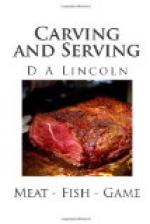In carving large rump steaks or round steaks, cut always across the grain, in narrow strips. Carving-knives are always sharper than table-knives, and should do the work of cutting the fibres of the meat; then the short fibres may easily be separated by one’s own knife. There is a choice in the several muscles of a large rump steak, and it is quite an art to serve it equally.
LEG OF MUTTON OR LAMB, OR KNUCKLE OF VEAL.
Before cooking, remove the rump-bones at the larger end. For a small family it is more economical to remove all the bones and fill the cavity with stuffing. Tie or skewer it into compact shape; there is then less waste, as the meat that is not used at the first dinner does not become dry and hard by keeping.
In serving, the thickest part of the leg should be toward the back of the platter. Put the fork in at the top, turn the leg toward you to bring the thickest part up, and cut through to the bone. Cut several slices of medium thickness, toward the thickest part, then slip the knife under and cut them away from the bone. A choice bit of crisp fat may be found on the larger end, and there is a sweet morsel near the knuckle or lower joint. If more be required, slice from the under side of the bone in the same manner.
LEG OF VENISON.
This is carved in the same way as a leg of mutton,—through the thickest part down to the bone.
SADDLE OF MUTTON.
Remove the ends of the ribs and roll the flank under before cooking.
Place it on the platter with the tail end at the left. Put the fork in firmly near the centre, and carve down to the ribs in long slices, parallel with the backbone, and the whole length. Slip the knife under and separate the slices from the ribs; do the same on the other side of the back. Divide the slices if very long. Cut the crisp fat from the sides in slanting slices. Turn partly over and remove the choice bit of tenderloin and kidney fat under the ribs.
Carving a saddle of mutton in this way is really cutting with the grain of the meat, but it is the method adopted by the best authorities. It is only the choicest quality of mutton, and that which has been kept long enough to be very tender, that is prepared for cooking in this way. The fibres are not so tough as those of beef; there is no perceptible difference in the tenderness of the meat when cut in this manner, and there is an advantage in obtaining slices which are longer, and yet as thin as those from cutting across the grain.
SADDLE OF VENISON.
Carve the same as a saddle of mutton. Serve some of the dish gravy with each portion. Venison and mutton soon become chilled, the fat particularly, thus losing much of their delicacy. Send them to the table very hot, on hot platters; carve quickly, and serve at once on warm plates.




